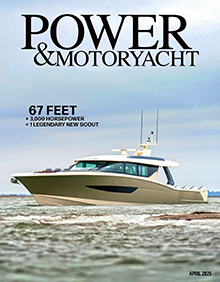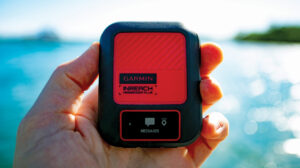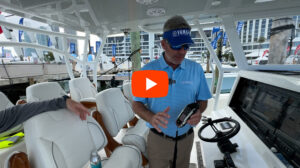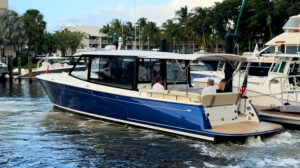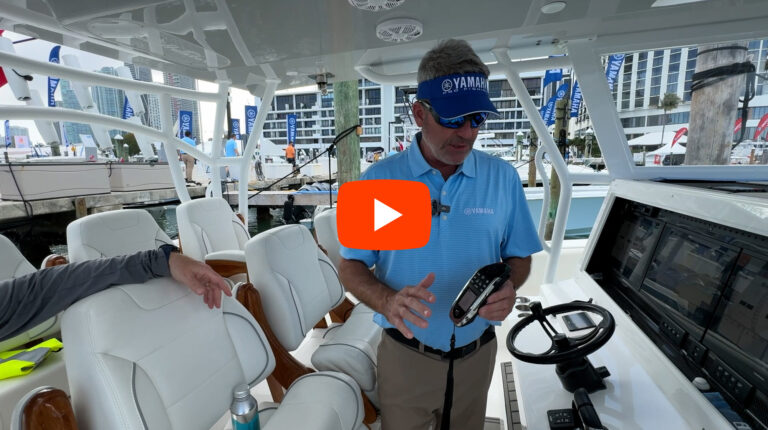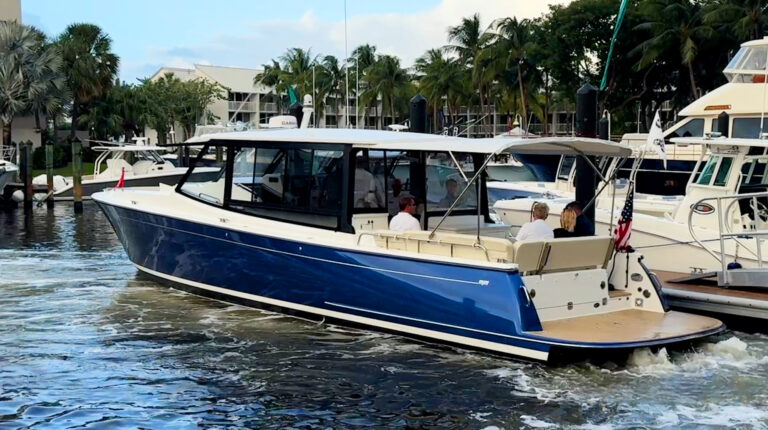Lost and Found
A number of products hitting the market promise to alert you if a person or pet goes overboard.
We investigate to see if they really can keep your crew safer at sea.

In man overboard (MOB) scenarios, time is the difference between a quick rescue and tragedy. Wireless man overboard systems immediately notify those on board, and in some cases will actually shut down the engines. Statistics show that when someone goes overboard and visual contact is lost, there is a 40 percent chance that person won’t be recovered. Early notification of an occupant falling overboard is crucial to improving those odds.
The needs for MOB systems vary. For an angler fishing alone, the most important feature may be an engine kill switch. For a crew member on a cruising boat, the first response should be to alert the captain. Today, there are systems to meet nearly every need. The price of entry is less than $100 for a Bluetooth MOB beacon that can be monitored from your phone. But systems can grow to monitor up to 15 crew members on boats up to 100 feet.
Weems & Plath’s CrewWatcher ($90) is a cylindrical Bluetooth beacon designed to attach to a PFD or clothing; because it has a water sensor on the bottom, it should be worn outside any layers of clothing.
When paired with the CrewWatcher beacon, the CrewWatcher app notifies users if someone falls overboard. A phone can monitor up to five beacons, which can be attached to people, pets and even objects like a dinghy. The beacon will set off the MOB alarm on the app if the beacon exceeds a predetermined range, or if it detects water. Weems & Plath says you can also use the beacon as a bilge alarm. The beacons have a non-replaceable battery that lasts between three and five years depending on usage.
An ACR OLAS system starts with the ACR OLAS app and an $85 watch-like tag or the $140 Float-On combination flashlight and beacon. The latter is also a water-activated strobe that’s recharged via USB.
The ACR OLAS app works similarly to the CrewWatcher app, but adds a solo mode. In solo mode, if a tag goes out of range and isn’t canceled within a short interval, an SMS message is sent to a predefined emergency contact including location and a time stamp of the event. This informs someone on shore of an MOB event as long as the boater has left the phone in a safe location on the boat (and not in their pocket). It’s important to note that the alarm will only sound if the app is open, which can drain your phone’s battery.
The Fell MOB+ wireless man overboard system forgoes an app for a module installed at the helm. The module can pair with up to 20 tags, and monitor four tags at a time. One tag is designated as the vessel operator—if that tag goes overboard, the engine kill switch is activated and an alarm sounds. The alarm is sounded if any of the other three tags are activated. The kill switch can be overridden by pressing and holding the button on the dash module. A bundle with one tag and the dash module goes for $200, and additional tags are $40.
The tags can be placed on a watch-band strap, attached by lanyard to a PFD or clothing, or clipped to a strap (or dog collar for four-legged crew members). The tags have replaceable batteries that last for 300 hours of active use.
Mercury Marine and Fell are working on an integration of Mercury’s SmartCraft suite of digital offerings and Fell’s wireless technology to deliver greater safety and convenience. So far, they’ve announced SmartIgnition, a keyless ignition and anti-theft feature with MOB capabilities included.
Other systems ensure passengers are immediately alerted if the captain goes overboard. However, each of these devices reveal the location of the boat when the crew member goes overboard; they don’t reflect the actual location of the person in the water.
An AIS MOB beacon (typically $225 to $300) will, when activated, send a man overboard signal—with the current position of the person overboard—to all AIS receivers within range of the beacon. The location is updated continuously, not restricted to point-of-loss as is the case with Bluetooth beacons. This means that both search-and-rescue organizations monitoring the area and other boats equipped with AIS receivers will be alerted to an emergency and can render assistance. In addition, several of the AIS MOB beacons send a VHF DSC (digital selective calling) distress signal, so any boats with their VHF radios on and in range will also receive a distress message.
Personal Locator Beacons (PLBs) operate using the same frequencies and technology as EPIRBs to notify rescue centers of distress. This notification occurs via a 406 MHz link to the COSPAS/SARSAT constellation of satellites. PLBs equipped with a GPS receiver (all currently available PLBs include GPS and typically retail for $300 to $400) send a numeric identifier of the PLB and the location. Rescuers are able to look up that identifier and retrieve information on the PLB owner. Now, they’re armed with information about who they’re looking for and their location. The current location is regularly sent to satellites, ensuring rescuers know exactly where to search. Unfortunately, unlike with an AIS MOB beacon, boats closest to the victim aren’t notified of the emergency or provided location information—the information is only sent to the satellite constellation and to first responders.
These technologies aren’t mutually exclusive. ACR has plans to bundle the OLAS tags with PLBs to offer a package ready for any situation. The ultimate best case kit for safety would be a combination AIS MOB beacon, PLB and Bluetooth MOB beacon. Both AIS MOB beacons and PLBs require the user to activate them; so, they’re best suited to adults and older children. For young children and pets, the automatic activation of the active beacons is a must-have.
For my own cruising, I have a 406 MHz PLB attached to my PFD and am adding an AIS MOB beacon. I’m also going to add a Bluetooth beacon to my daughters’ PFDs. There are many ways to increase the safety of the occupants of your boat, and most solutions will cost less than a day’s fuel bill. But can you really put a price on peace of mind?

